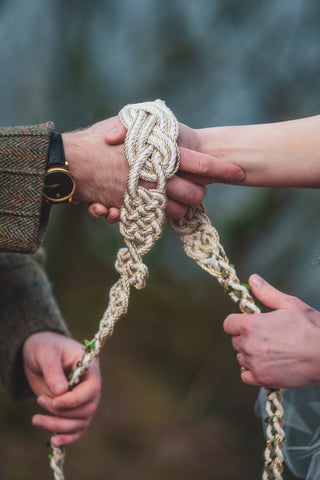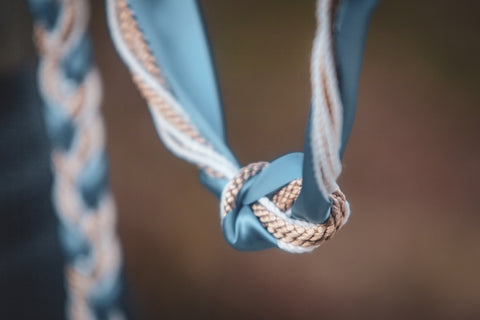Confused about the difference between an Infinity Tie and a Center Knot?
Don't worry! On this page we have a Video explaining the two different cords, a written explanation, as well as a handy comparison chart!
Infinity Tie and Center Knot Design
How to tie our handfasting cords
Different officiants may have different approaches to the way they tie the rope or the words that are used. The couple usually either holds both hands crossed in front of each other or holds one opposite hand each (like shaking hands) – although I have also seen ceremonies where the partners simply stand next to each other and hold each other’s closest hand (my own wedding included). How you hold your arms is entirely up to you. In terms of tying the actual knot, the cords I design fall into two different categories:
Decorative centre knots

Decorative Centre Knots feature a decorative knot in the middle of the cord which is placed on top of the couple’s hands. The sides are then wrapped around the wrists of the partners and tied in a simple knot underneath. This is a straightforward, easy technique that highlights the symbolism of the centre knot and can be beautifully displayed before and after the ceremony.
Infinity knots

Infinity handfasting cords are loose in the middle, with decorative knots and braids along the sides. This allows for the cord to be tied in such a way that, once the hands are slipped out, an infinity knot remains in the cord. This is a slightly trickier way of doing it – and I’d definitely recommend practising beforehand – but you get to keep the literal knot you tied at your wedding which makes for the most wonderful keepsake.
Have a look at our comparison table below!
|
Decorative knots |
Infinity knots |
| Straight forward, easy technique that highlights the symbolism of the centre knot. |
Advised that you use a celebrant for this type of knot tying in the ceremony. |
| Great for communal handfasting ceremonies and you don't need a celebrant present for this technique. |
It is best to practice tying this type of knot before your ceremony as it is slightly more complex.
|
| More flexible option as you can do several knots. |
You get to keep the literal knot that you tied at your ceremony which makes the most wonderful keepsake. |
Both of these ways of tying the knot are equally 'right'. Ultimately, the most important thing is that the tying technique you chose works for your ceremony
